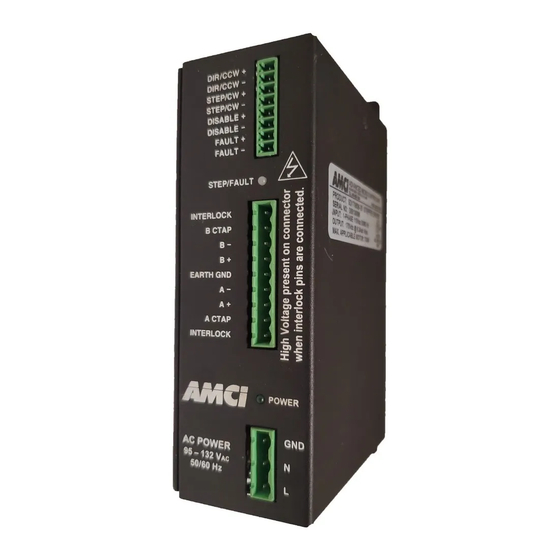AMCI SD17060B-03 Panduan Pengguna - Halaman 17
Jelajahi secara online atau unduh pdf Panduan Pengguna untuk Penggerak Servo AMCI SD17060B-03. AMCI SD17060B-03 20 halaman. Stepper drives

TROUBLESHOOTING
Motor Problems
Symptom
The motor has no holding
torque.
The SD17060B blinks its
FAULT
LED green when pulses
are applied to the driver, but the
motor only emits a high pitch
noise. It does not rotate.
The motor only runs in one direc-
tion.
The motor runs backwards. (CW
instead of CCW and/or CCW
instead of CW)
As its running speed increases,
the motor begins to run rough,
and eventually stops while
pulses are being applied.
The motor runs erratically.
As noted above, sometimes a problem that appears to be with the motor is actually a problem
with the indexer. The SD17060B has a Self-Test feature that allows you to verify motor opera-
tion without an indexer. With power applied to the driver, toggle the SB4-1 switch. The motor
will begin to rotate clockwise at 60 RPM. You must remove power to the driver to end the self
test. Please remember to return SB4-1 to its original position before cycling power to the driver.
20 Gear Drive, Plymouth Ind. Park, Terryville, CT 06786
Tel: (860) 585-1254 Fax: (860) 584-1973 http://www.amci.com
Solution
1) If the Step/Fault LED is red, then a problem exists with the driver or
motor. Refer to Power Connector and Indicator LED's on page 13
for information.
2) If the motor rotates when commanded but has no holding torque,
then your Idle Current Reduction switch is set to the To 0% setting.
This setting removes motor current when the driver is idle for more
than one second. There are other idle current reduction settings
available. See Switch Settings on page 9 for more information.
3) The SD17060B ships with the motor current set to its minimum
value of 1.0 amp. It's possible that it was not set for your applica-
tion. See Switch Settings starting on page 9 for the proper switch
settings.
STEP/
1) The acceleration or starting speed values may have been set too
high when the indexer was programmed. The motor may start to
accelerate and stall as the acceleration increases.
2) The Step Resolution may be set to a values lower than you are
expecting. For example, if the Step Resolution is set to 200 instead
of 400, the acceleration value is effectively doubled.
This problem is usually caused by the directional pulse inputs. If your
indexer is sending pulses in the CW/CCW format and the driver is con-
figured for the Step & Direction format, the motor will rotate counter-
clockwise when the driver receives CW pulses, and it will not rotate at
all when the driver receives CCW pulses. If the indexer is sending
pulses in the Step & Direction format and the driver is configured for
the CW/CCW format, the motor will only rotate clockwise, even when
the indexer is commanding a counter-clockwise move.
1) One of the motor phases may be reversed. The "quick fix" is to
reverse the connections on the ±B windings.
2) There may be a problem with the directional inputs. Either they are
wired incorrectly or the format is wrong. Check wiring and see the
previous problem for more information on problems with format.
1) If you are using single ended outputs for your pulse and direction
signals, you may have a problem with the outputs not switching fast
enough. See the note on the R
Indexer section on page 10.
2) You may have a problem with resonance in the system. Run the
system with the Anti-Resonance feature enabled and disabled to
see which give you better performance. The Anti-Resonance fea-
ture is set with SB1-5. See page 9 for more information.
1) The motor is not correctly coupled to the load.
2) The deceleration rate is set to high and the inertia of the load is car-
rying the motor past the point where it is supposed to stop.
3) You are performing a slow move, (under 1 revolution/second) while
the Step Resolution is set to 200 or 400 steps/turn. To correct this
problem, try increasing the indexer's starting speed parameter. Do
not increase the starting speed beyond your slowest running speed.
4) The motor current is set too low and the motor is unable to move
the load.
5) The motor is not correctly wired. Eight lead motors can be wired in
series or parallel. Series connection gives you more torque at lower
speeds and parallel connection gives you more torque at higher
speeds.
Resistor in the Connecting Your
LD
17
